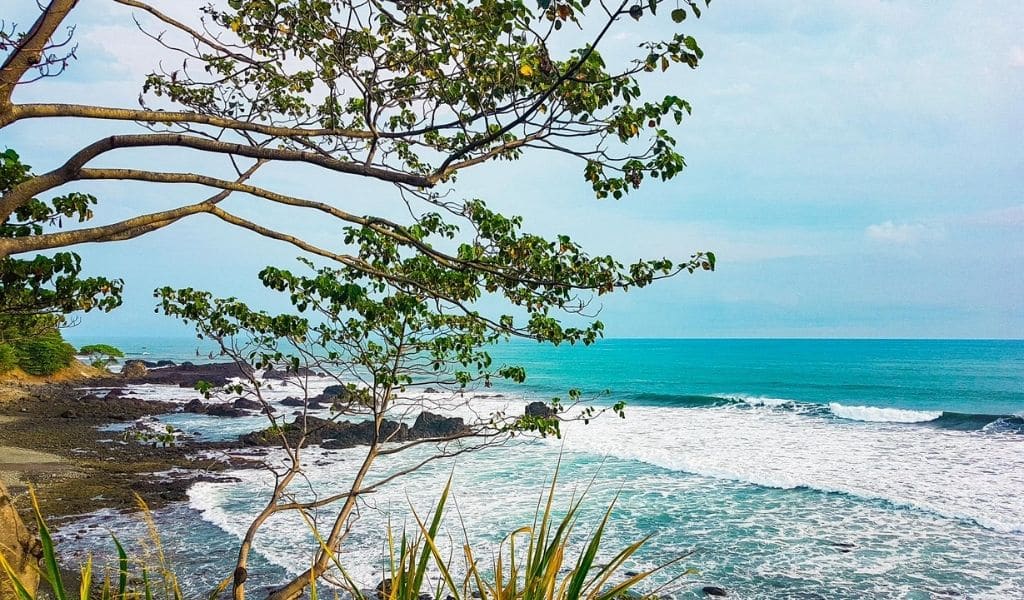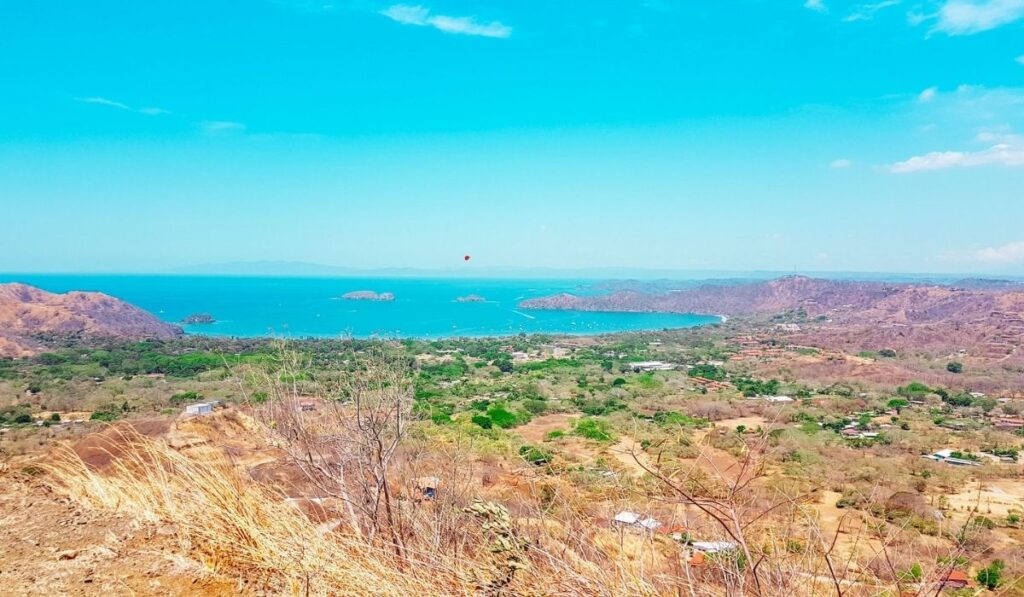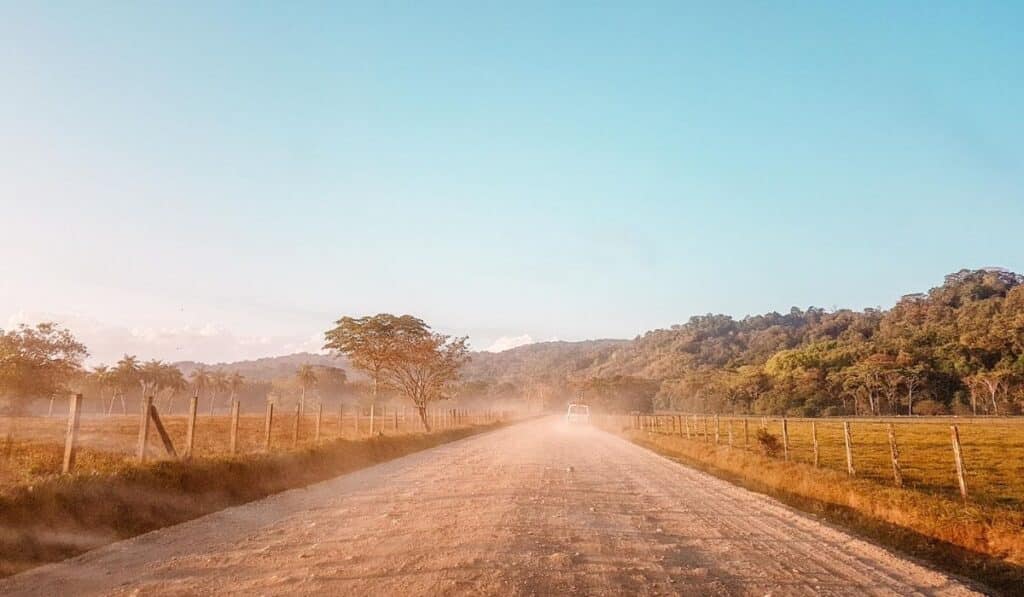Costa Rica Weather by Month and Location
Every area and month of Costa Rica analyzed so you can plan your dream vacation and have the best weather possible.

The number one question we get asked here at Costa Rica Vibes is, “What is the best time to visit Costa Rica?”
The weather in Costa Rica is so different depending on the time of year. Plus, there are so many different climate zones. Some areas of the country are better than others in certain seasons.
There really is no “best” time to visit this beautiful country.
Instead, each month brings its own set of weather pros and cons and best/ worst locations.
We created this guide to help you figure out when is the best time and place for you, with your specific interests, to visit.
So, lets get to understanding the weather and climate in Costa Rica!
Costa Rica Weather at a Glance
– The dry season runs from mid-December through late April
– The rainy season runs from late April through mid-December
– The Caribbean coast has the opposite rainy season than the Pacific Coast
– Sun and overheating should be your number one weather concern here
Costa Rica 10 Day Forecast
First off, here is the 10 day forecast for some of the popular areas in Costa Rica.
SAN JOSÉ PROVINCE WEATHER GUANACASTE PROVINCE WEATHER SANTA TERESA BEACH WEATHER MANUEL ANTONIO WEATHER LIMÓN PROVINCE WEATHERKeep in mind that if you are visiting during the rainy season and it says rain and lightning every day, all day, this is most likely not true.
I swear the weather forecasters just go on vacation for the entire rainy season.
It is very rare to actually have a full day of rain (unless you are visiting in October).
Costa Rica Climate by Region
The country has seven regions. Here is a general overview of the Costa Rica weather in each area by season.
Guanacaste Region
This area in the northwest part of the country consists of mostly tropical dry forest. The temperatures here tend to be higher than a lot of other parts of the country and there is usually far less rain.
The province experiences a prolonged dry season, usually lasting from November to May. Sometimes it is so dry that you will see fires in the hills above the beach towns.
During the dry season, temperatures in Guanacaste can range from around 85°F (29°C) to 95°F (35°C).
In contrast, the rainy season in Guanacaste typically occurs from May to October, bringing occasional showers and thunderstorms.
Usually, these rain storms will roll in for a few hours in the afternoon and then the weather will clear up.
The Nicoya Peninsula
This area experiences a tropical climate with distinct wet and dry seasons.
During the dry season, which typically lasts from December to April, the Nicoya Peninsula rarely receives rainfall, and the weather is generally sunny and hot.
The temperatures during the dry season range from around 80°F (27°C) to 95°F (35°C).
However, during the rainy season, from May to November, the Nicoya Peninsula experiences more frequent rainfall, with September and October being the wettest months.
The rainy season brings cooler temperatures, ranging from around 75°F (24°C) to 85°F (29°C), and while rain showers can be expected, they are often followed by breaks of sunshine.
The Central Pacific
The dry season on the Central Pacific coast spans from late December to late April. During this period, the area experiences higher prices and larger crowds, particularly in popular beach towns like Jaco and Manuel Antonio.
As May arrives, prices tend to decrease slightly, and the crowds disperse. This is the start of rainy season. Expect afternoon rainstorms lasting about one to two hours, but it’s rare to encounter an entire day of rain.
From August to December, prices typically drop even further, and it becomes more likely to experience rainy days.
The temperature remains relatively consistent year-round, with daytime temperatures reaching the upper 80°F (around 30°C) and dipping to around 65°F (19°C) at night.
The sun rises between 5:15 and 5:45 am and sets between 5:30 and 6:00 pm throughout the year.
Central Valley
The Central Valley, where the capital city San José is located, has a pleasant climate with mild temperatures all year.
This is where we live and we love the moderate temperatures.
The yearly weather in the Central Valley is relatively stable with temps ranging from 75°F (24°C) to 80°F (27°C) and cooler evenings.
The region has a distinct dry season from December to April and a rainy season from May to November.
The Northern Mountains
This area consists of cloud forests like Monteverde and higher elevations in towns like Alajuela. The Northern Mountains follow a similar rainy and dry season pattern to the Pacific coast, but there are slight variations.
It is not unusual to experience some unexpected rain showers even in the dry season and have random days of no rain in the rainy season.
In general, the temperatures here are cooler. In Monteverde, it can actually be really cold.
Side note: I just looked up the temperatures in Monteverde and really it actually only gets down to the high 50’s on a really cold day. I think I’ve lived in Costa Rica too long that I now think this is cold. My Massachusetts blood has thinned haha.
Daytime average temperatures typically range from around 70°F (21°C) to 80°F (27°C).
Caribbean Coast
The Caribbean coast of Costa Rica offers a contrasting weather pattern compared to the rest of the country.
Here, the dry season begins in August and extends through early December.
You can also often expect decent weather in April and May.
Throughout the remainder of the year, some washout rainy days are possible with July tending to be the rainiest month.
August through October are generally the driest months.
The temperature throughout the year typically reaches the upper 80°F (around 30°C) during the day and cools to around 65°F (19°C) at night.
Sunrise occurs between 5:15 and 5:45 am, and sunset takes place between 5:30 and 6:00 pm.
Since you’re on the Caribbean coast, waking up early to witness the beautiful sunrise is a must-do experience!
The Osa Peninsula
This area, which includes Corcovado National Park, has a tropical rainforest climate. During the dry season you can expect warm temperatures and dry weather.
However, the rainy season here can be more intense than some other parts of the country.
For example, Corcovado National Park’s entrance at Sirena actually closes in October because the rain is usually so intense.
Caribbean Coast versus Pacific Coast Weather
The Pacific and Caribbean coasts of Costa Rica have opposite rainy seasons.
The dry season on the Pacific coast tends to run from mid-December until early May.
On the Caribbean coast, the weather is usually best in April and May and then again from August to early October.
For more info check out our guide to choosing the Pacific or Caribbean coast for your travels.
Dry Season versus Rainy Season

The picture above was taken near Playas del Coco in Guanacaste Province in late February. See how dry it is?
It is not unusual for this area to experience a lot of fires after several months of zero rainfall.
During the dry season, you can expect almost no rain and hot days.
The downfall of this time of year is that everything turns brown from the lack of water and it is the most popular time for tourists.
That means prices can be super high for hotels and activities.
On the Pacific coast, during the rainy season, the rain tends to roll in around 2pm and lasts for a few hours.
Later in the year (September – December) the rain can become worse and last for longer during the day.
At this time of year all the prices go down, there are fewer tourists, and everything turns green again, hence why the rainy season in Costa Rica is also referred to as the green season.
What Are the Pros and Cons of Visiting During Each Season?
Dry Season Pros
Less rain means more sunny days to enjoy outdoor activities like swimming, hiking, and exploring.
Many popular tourist destinations have vibrant green landscapes due to recent rains.
Wildlife sightings are more common as animals gather near water sources.
Dry Season Cons
It can be hotter and more crowded with tourists, especially in popular areas.
Some natural attractions like waterfalls and rivers may have lower water levels.
Rainy Season Pros
Lush greenery and blooming flowers create beautiful landscapes.
Fewer tourists mean less crowded attractions and lower prices for accommodations.
The rain can provide a refreshing break from the heat.
Rainy Season Cons
There can be heavy downpours and thunderstorms that may limit outdoor activities.
Certain roads and trails may become muddy and difficult to navigate.
Wildlife sightings may be less frequent as animals seek shelter from the rain.
Costa Rica Weather by Month
Let’s go through the weather in Costa Rica by month of the year so that you can get a better idea of what to expect during your trip.
Costa Rica Weather in January: In January you can expect no rain and hot hot temperatures on the Pacific coast. In San Jose, the weather is warm and windy.
On the Caribbean coast, you can expect frequent rainstorms and a lot of humidity.
Costa Rica Weather in February: Just like with January you can expect hot temperatures and no rain on the Pacific coast. In San Jose it is dry and a bit less windy than in January.
On the Caribbean coast, you can expect humid temperatures and some rain storms.
Costa Rica Weather in March: In March you can expect hot weather on the Pacific coast. You may have one or two days with afternoon thunderstorms (but it is pretty rare).
Costa Rica Weather in April: April means hot weather and the possible start of the rainy season.
You never really know because it is different every year, but especially later in the month, you might deal with the occasional afternoon thunderstorm.
Costa Rica Weather in May: In May, the rainy season officially begins. You may not have rainstorms every day, but they definitely become more frequent.
Typically the rain storms roll in around 2pm and last for no more than two hours.
Costa Rica Weather in June: June is not a bad time to visit Costa Rica. You can expect afternoon thunderstorms almost every day, but the weather is hot and good for the rest of the day.
Costa Rica Weather in July: July is actually one of our favorite months to travel around the country. Everything is back to being really green and you can expect hot sunny days with the afternoon thunderstorms like clockwork. There are a fair amount of tourists because it is summer vacation time, but not as many as earlier in the year.
In July there is also (usually) a two-week break from the rain.
Costa Rica Weather in August: August in Costa Rica can be a bit wet and gray. Sometimes you will have absolutely perfect days with no rain, other times you might have afternoon thunderstorms, and some days will just be overcast. However, there are very few days which are complete washouts.
August is the best time to visit the Caribbean coast. The weather tends to be hot and rain-free over there.
Also, it is turtle season in Tortuguero, so it is the perfect time to head to the east coast of the country.
Costa Rica Weather in September: Just like with August, you can’t really predict the weather in September.
This past September we spent four nights on the Pacific coast and didn’t have a single drop of rain the entire time. Other years it has been a lot more rainy with the typical afternoon storm.
Costa Rica Weather in October: October is known for having the worst weather in the country. You can expect some days of full rain. In San Jose where we live, this is the month when we deal with flooding due to some very heavy rainstorms.
Costa Rica Weather in November: November is kind of completely up in the air. Some years have been nonstop rainy and others have been sunny and hot with very little rain. Basically, November is a surprise month.
Costa Rica Weather in December: In December you have very little chance of dealing with rain (but it can still happen especially during the beginning of the month).
Instead, you will have hot temperatures on the Pacific coast, warm windy weather in San Jose, and some possible rain on the Caribbean. Get ready to hear every local say, “It’s Christmas weather!.”
If you plan on booking your vacation during the week of Christmas, book early and be prepared to pay top dollar for hotels and activities.
What Should I pack for Costa Rica in the Rainy Season versus Dry Season?
Packing for Costa Rica varies depending on whether you’re visiting during the rainy season or the dry season. Here are some essential items to consider for each season:
Rainy Season Packing
Pack a lightweight waterproof rain jacket or poncho to keep you dry during sudden rain showers.
Opt for lightweight, quick-drying clothing made of materials such as nylon or polyester. These fabrics dry faster in humid conditions.
Keep your electronics, documents, and other valuables protected by packing them in waterproof bags or using a waterproof cover for your backpack or daypack.
Consider bringing water-resistant or waterproof shoes, such as sturdy sandals or waterproof hiking boots, to keep your feet dry and comfortable.
Although the rainy season is generally warm, some regions and higher elevations can be cooler. Pack a light sweater or jacket for cooler evenings or if you plan to visit cloud forest areas.
Check out our guide to packing for the rainy season for more details.
Dry Season Packing
Choose lightweight, breathable clothing made of natural fibers such as cotton or linen to stay cool in the warm and sunny weather.
Pack sunblock with a high SPF, sunglasses, a wide-brimmed hat, and lightweight, long-sleeved shirts for additional sun protection.
Don’t forget to pack your swimsuit! The dry season offers plenty of opportunities for swimming and enjoying Costa Rica’s beautiful beaches.
While the days are generally hot, evenings can be cooler. Bring a light sweater or jacket for any temperature drops, particularly if you’re visiting higher elevations.
What is Veranillo in Costa Rica?
“Veranillo” is a term used in Costa Rica to refer to a weather phenomenon known as the “Little Summer” or “Dry Spell.”
Veranillo occurs during the rainy season, typically in July. Usually during this month, there is a temporary break in the regular pattern of rainfall.
Veranillo can vary in duration and intensity each year, and it doesn’t always occur. Some years may have a more pronounced Veranillo, with an extended period of dry and sunny weather, while in other years, it may be less noticeable.
How Are the Driving Conditions in Rainy Season versus Dry Season?

During the dry season, driving conditions in Costa Rica tend to be better. The dry roads make it easier to navigate, and visibility is generally good.
However, some areas may experience occasional dust storms, especially in the drier regions of Guanacaste and Nicoya Peninsula. So, definitely keep an eye out for that.
Dry season means peak tourist season in Costa Rica, which means there may be more traffic on popular routes and around tourist destinations.
Driving conditions can be more challenging during rainy season. The rainfall can be heavy at times, leading to wet and slippery road conditions. Some roads may become muddy, especially in rural or less-developed areas.
In the rainy season, it’s crucial to exercise caution while driving. Reduce your speed and maintain a safe distance from other vehicles. Be prepared for reduced visibility due to rain and fog, especially in mountainous areas or cloud forests..
Also there is a higher risk of encountering flash floods or landslides during heavy rainstorms.
Certain areas of the country (near Nosara, parts of Nicoya, and down in the Osa Peninsula) have river crossings. Often you won’t be able to navigate these during the rainy season because the water level will be too high.
How Strong is the Sun in Costa Rica?
Keep in mind that Costa Rica is not that far from the equator. The sun here is powerful!
In fact, the most common medical treatment that visitors to Costa Rica end up needing is due to over-exposure from the sun and bad burns.
We have a full guide to protecting yourself from the sun in Costa Rica to help you out.
And our number one tip is to buy a long sleeve shirt for swimming.
In our experience, people on beaches or during day boat tours when they are just wearing their bathing suits is the number one time for bad sun exposure.
Are the Mosquitos Bad in Costa Rica?
There are mosquitos in Costa Rica. They tend to be more of a problem during the rainy season and in the evenings.
When you go out to dinner, we always suggest bringing a bottle of bug spray with you. The second the sun goes down the mosquitos come out.
Unfortunately, mosquitos here have been known to carry illnesses such as Zika and Dengue.
Find out how to protect yourself and what to look out for with our guide to Costa Rica mosquitos.
What are Some Natural Disasters in Costa Rica?
Costa Rica is known for having earthquakes and occasional volcanic eruptions.
It is always best to register with STEP if you are a United States citizen. This will allow the US government to get in contact with you and keep track of you if a natural disaster occurs while you are traveling.
For more tips check out our guide to natural disasters in Costa Rica.
Does Costa Rica Get Hurricanes?
Typically, Costa Rica does not experience a lot of hurricanes or tropical storms like a place like Florida experiences. Usually, these types of storms that come up the Caribbean Sea don’t turn in the direction of Costa Rica.
However, very rarely tropical storms and hurricanes occur.
They tend to hit the Caribbean side of Costa Rica, but we were here in 2017 when the Pacific Coast was hit by a tropical storm that caused a lot of destruction.
As with natural disasters, always register with STEP (if you are traveling from the United States) so that the government knows where you are and can notify you in case of an impending storm.
Things to Keep in Mind About the Weather in Costa Rica
– If you are planning to rent a car, we have a 10% discount plus other great perks with Adobe. Their rate fluctuates by season, not by when you book.
In other words, it is best to book your car now so you can guarantee you’ll have one.
The price will not be cheaper if you wait longer, but they may run out of cars if you don’t book in time.
This happens a lot in the dry season.
– We have created destination guides to every location in Costa Rica. All of these destination guides include detailed weather descriptions.
Definitely check these out for more details about the weather in the areas you are planning to visit.
– Costa Rica is in the northern hemisphere and experiences a consistent 12 hours of sunlight every day all year round. You can find out more in our guide to time in Costa Rica.
– All of our descriptions about the weather in Costa Rica are predictions. It can be really hard to say exactly what it will be like here. We have lived here since 2016 and every year has been different.

You Might Also Like
Complete Guide to Costa Rica Culture
Money and Currency Guide to Costa Rica
Eating in Costa Rica: Guide to Food
….if none of those appeal to you, check out our Must Know Planning Info on Costa Rica for more trip-planning advice
